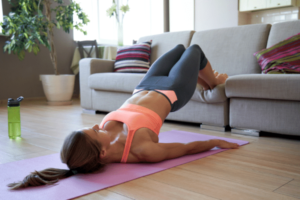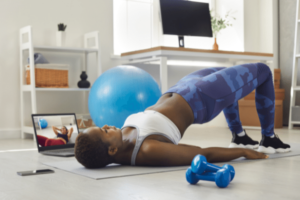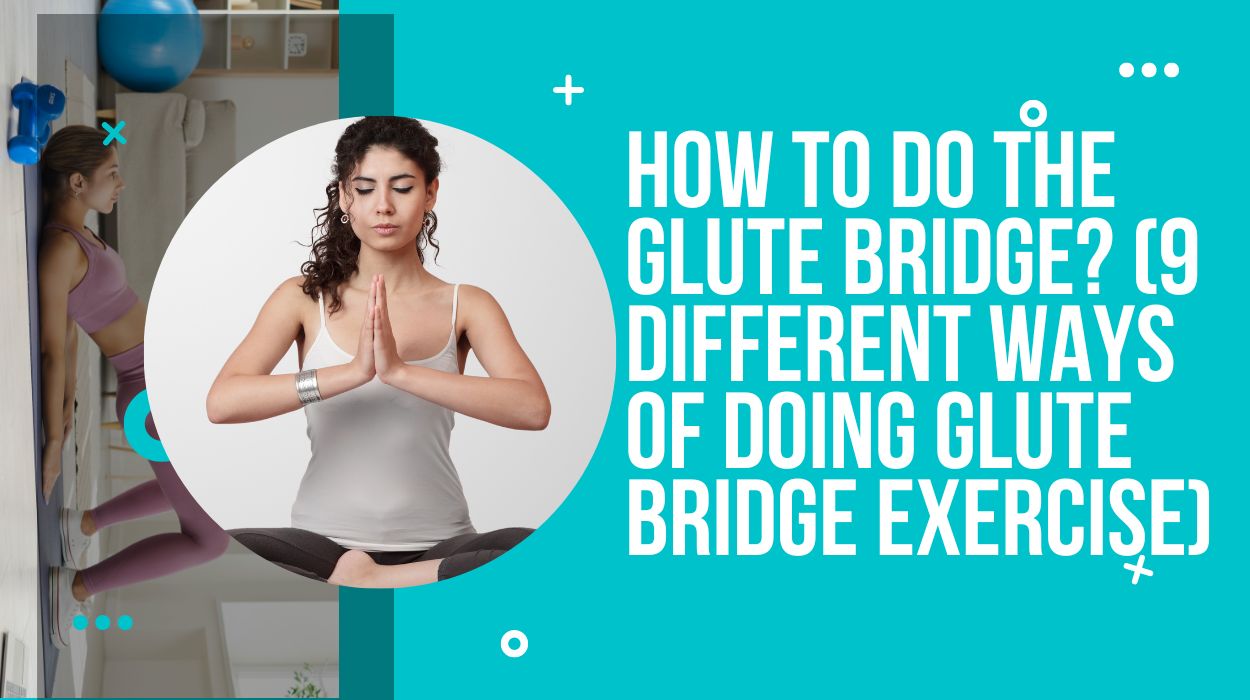The glute bridge is a strengthening exercise that works the muscles of the back and buttocks. It is a great core exercise that is used as a standalone ab exercise and a bridge to a standing crunch or front raise.
It is a fundamental core workout in which you raise your body. This exercise strengthens the gluteus maximus muscle. It is excellent for increasing strength and endurance in your lower back and hips. It is a great ab exercise because it works out a large portion of your core. It also strengthens the lower back muscles.
Let’s have a look over how the Glute bridge works, the benefits of doing it, and 9 different ways of doing the glute bridge exercise the right way.
How does glute bridge exercise work?

Assume a plank position on your hands and knees to do a glute bridge. Lift your hips upwards towards the ceiling and then return to starting position. Repeat 5-10 times.
The gluteus maximus is a primary muscle of the buttocks, which gets direct effect through this exercise. It is a deep muscle that covers the buttocks and the upper part of the inner thighs. It is usually considered a hip muscle, although it is part of both the gluteal and hip groups.
The rectus abdominis is another prime muscle of the back and abdomen. It inserts into the upper part of the pubic bone, the xiphoid process, and the anterior surface of the 11th rib and extends to the upper part of the ribs and the inner surfaces of the upper arm. It is a prime stabiliser of the spine. The glute bridge exercise helps in preventing this muscle from collapsing and injuries.
Because it works so many of the major muscle groups, it is an excellent exercise for the core as a whole. The glute bridge builds strength and endurance in your lower back and hips, which are often affected by many of the injuries that people incur.
Benefits of doing a glute bridge exercise

- One of the advantages of the glute bridge is that it strengthens the gluteus maximus and the hamstrings. The gluteus maximus is a prime stabilizer of the spine, so strengthening it will make it easier to prevent back pain.
- Hamstrings are crucial for running, and strengthening them will make it easier to run longer distances. Strengthening the gluteus maximus and the hamstrings will help prevent back problems in people who sit at work.
- The glute bridge exercise is pretty much just what it sounds like. You assume a plank position on your hands and knees, lift your hips towards the ceiling, and return down. Repeat 5-10 times.
There are various ways to do the glute bridge:

First
If you are not familiar with the gluteus maximus muscle, you may not know what to look for. The gluteus maximus is located just beneath the buttocks and is a deep muscle, so it may take time to feel it. It may take some practice to handle it. The best way to see if you are working the muscle is to use your knee as a guide to feel the muscle. Be sure to keep your knee straight because you are working the power the most.
Second
The glute bridge can be done with or without weights. However, if you want to make this exercise more challenging, you can try doing the glute bridge with a weight. If you have weight, you will be able to raise your body more. If you do not have weights, you should do the glute bridge with your hands on the floor. There will be times when you don’t have to be able to push your body up, so you should do the glute bridge without weights as long as you are able.
You can do the glute bridge without weights if you are just getting started and want to really test how to do it. Or, if you put a set of weights on your hips and do the exercise, then the glute bridge is easy to do.
Third
The glute bridge can be done with your heels on the floor or a platform such as a step. Doing the glute bridge with your heels on the floor will allow you to feel the muscle working. However, doing the glute bridge with your feet on a step will enable you to lift your hips higher, which will allow you to feel the muscle working better. Your feet may move closer together as you lift your hips higher. It is not a problem if you are doing the glute bridge and want to feel the muscle working, so don’t worry about this.
Fourth
You can use your hands to help raise your hips up. You can do this by resting your hands on the floor and then pushing down, or you can grip the bar that you will be lifting with and use your hands to raise your hips. If you use your hands to help raise your hips up, you will have to lift your hips more slowly, and you will not have to use as much strength. So you can use your hands to help raise your hips if you are trying to feel the muscle working.
Fifth
And this is a personal preference, you can do the glute bridge from start to finish with your back on a chair, or you can do it kneeling on the floor and then standing up again. Doing the glute bridge from start to finish will allow you to feel the muscle working throughout the entire glute bridge.
However, you may find that the glute bridge is more accessible if you start with your back on the chair and then lower yourself down to your knees. If you kneel on the floor, you may only see your heels, and it may be hard to see where your back is. Your body may not be in a straight line. You should make sure that your lower back is straight and also that your glutes are not touching your knees, keep them slightly apart.
Sixth
In order to avoid injury, you need to work out a few muscle groups at once. If you are doing a glute bridge in a gym, you may find a box to stand on. You can use this by adjusting the height of the box or bench and using a step so that you can get a slight increase in your height. If you are not sure what you are doing, you can do a modified glute bridge, where you lift the knees off the floor and just lift your hips up. This will work your core and gluteus maximus but will not require you to raise your body as high as the standard glute bridge. You will find that you cannot use your arms for this, as the arms will interfere with the movement.
Seventh
Start with low reps and work your way up if you are just a beginner. The other way you can make this exercise easier is by having a solid stability challenge. For example, you can challenge yourself by having your feet on a stability ball or a foam roller. You can lie on a stability ball and then raise your hips off the ball. When you are in this position, raise your hips without raising your body up. This will allow you to feel the muscles working. It will also allow you to feel how much you have strengthened your core.
Eight
If you have to use a platform to work the glute bridge, you will be working for a much larger muscle group. There are many exercises if you want to go through the list and can perform from a standstill position. If you are standing on a platform, you can place your feet on the box and lift your knees off the floor. You can then lift both your hips and knees off the platform and feel the muscles working. This will also allow you to feel how much you have strengthened your core.
Ninth
You can do a simple glute bridge, where your body is entirely upright and where your core is doing all of the work. You can also do a glute bridge with a slight anterior pelvic tilt. In this exercise, your core is working more to control your body posture and allow you to feel more of the muscle working. Make sure that you work your core, gluteus maximus, and hamstrings. You can also try a lunge with a Swiss ball.
FAQs
1. How long should a glute bridge be held?
Lift your hips high so that your body forms a line from your knees to your shoulders. Be cautious not to let your hips slip down onto the pad. The purpose of this exercise is to keep a glute bridge position for 20–30 seconds.
2. How many glute bridges I should perform every day.
What Is the Appropriate Number of Bridges to Build? Glute bridges may be done as part of a warm-up every day and if you do so, aim for a single set of 10 reps. Consider completing three sets of 10 reps three to four times per week if you want to include them in your strength regimen.
3. What happens if I practice bridges every day?
Bridges should be done on a daily basis (particularly after extended periods of sitting) to assist “wake up” the glutes and realign the pelvis. This trains the body to remember to move via the hips (glutes) rather than the more vulnerable lumbar spine.
You May Also Like To Read:
Best Fat Burning Exercises To Do At Home
Yoga Vs Gym: Which Is Better For You?
Conclusion:
The glute bridge is one of the best exercises for building a strong and shapely backside, and it also strengthens your core and improves your posture. If you’re not incorporating glute bridges into your workouts, you’re missing out on a great opportunity to get better results in less time.
The glute bridge is an exercise that targets your glutes, or the muscles on the backside of your hips. It’s a great option if you want to build a strong, shapely backside, but it’s also a great option if you want to improve your posture.


